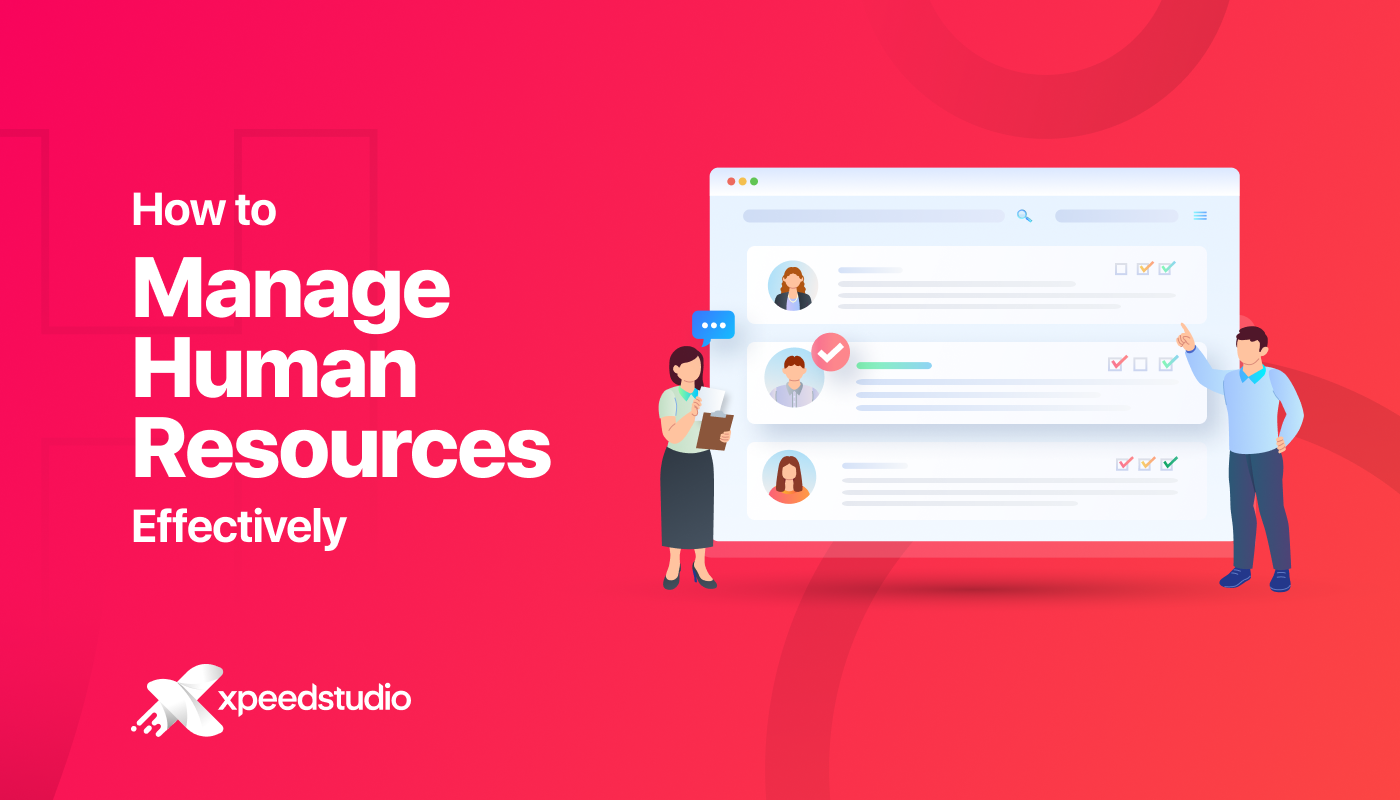How To Manage Human Resources Effectively: 5 Best HR Tools and Tips

Whether you are running a company or managing a project, it all depends on people at the end. Project management has multiple resources to work with, and human resources are one of the main aspects of management. And managing human resources can get very tedious.
In this blog, we present you with the most practical and insightful tips on how to manage human resources effectively. From talent acquisition strategies that reel in the best candidates to fostering a positive company culture that boosts employee morale, we’ve got you covered.
So, say goodbye to HR headaches and hello to a dynamic workforce that propels your organization to new heights, as we dive into the problems and possible solutions that will make your life easier. For managing human resources effectively, we will be sharing tips and HR tools you can use.
Understanding the Role of Human Resources Management (HRM)

HRM encompasses a wide range of responsibilities, from recruitment and talent development to employee engagement and compliance with labor laws. In this section, we will explore the key roles and functions of Human Resources Management and its significance in fostering a productive and harmonious work environment.
The prominent roles of human resources management are:
1. Job analysis
Conducting a job analysis helps determine the necessary skills and experience to do a job well. It helps the HRM hire the right candidates, create a fair compensation scale, and design training programs that align with the roles.
2. Workforce operations
Handling various aspects of workforce operations, like implementing health and safety policies, managing employee grievances, and providing enough facilities for the employee to thrive in the workplace, is vital for maintaining a positive work environment.
3. Performance measurement
Evaluating employee performance through various tools and metrics to encourage growth also serves as a decision-maker for raises, promotions, and dismissals.
4. Incentive programs
Implementing incentive programs that recognize achievements and reward high performers with bonuses and other perks to increase overall productivity.
5. Professional development
From employee orientation to advanced training programs, it’s a necessary task for human resources management to foster professional development to increase workplace productivity.
Common Challenges Faced in Human Resources Management
Managing human resources effectively can be quite challenging, especially for small and medium enterprises. Here are some common challenges that HRM faces –
1. Talent Acquisition and Retention
Attracting and retaining top talent is a perpetual challenge for HRM. In today’s competitive job market, finding skilled and qualified candidates who align with the company’s culture and values can be demanding.
Additionally, retaining valuable employees in the face of enticing offers from competitors can be equally challenging.
2. Employee Engagement and Morale
For productivity to increase and turnover to be reduced, it is essential to keep employees engaged and motivated. Low morale among employees can result in a decline in commitment, job satisfaction, and absenteeism.
3. Workplace Diversity and Inclusion
Promoting diversity and inclusion in the workplace is essential for fostering innovation and a positive work environment. However, managing a diverse workforce can pose difficulties in terms of understanding, addressing, and communicating with employees from different backgrounds, cultures, and viewpoints.
4. Managing Employee Performance
Effective employee performance management necessitates a fair and consistent approach to evaluations, feedback, and performance improvement plans. Providing constructive criticism while motivating employees to excel can be a delicate balancing act.
The role of HRM Technology
Technology has revolutionized the way organizations operate, and Human Resources Management (HRM) is no exception. With the advent of advanced software systems, automation tools, and artificial intelligence, the role of HR professionals has evolved tremendously.
Human Resource Software, also known as Human Resources Management System (HRMS) or Human Resources Information System (HRIS), is a digital solution that integrates various systems and processes to effectively manage and enhance daily HR tasks and overall HR objectives for an organization.
The main features of HRM Technologies
Manually managing HR functions can be time-consuming, ineffective, and expensive for small businesses with few resources and employees. Fortunately, the advent of human resource management software has made the process easier, allowing small businesses to streamline HR processes and focus on core business functions.
There are a plethora of software solutions to help improve HRM, as they offer a range of features according to their types. Here are some key features to look for when choosing HR software for any type of business in general:
1. Applicant Management and Recruitment
Small and medium enterprises need to seek out and hire top talent through effective recruitment. Look for HR software that includes features such as job posting, resume tracking, applicant screening, and interview scheduling. Automated messaging templates can also help streamline the hiring process by keeping candidates updated and interested.
2. Attendance and Leave Management
Keeping track of employee absences and leave can be a difficult and time-consuming task. Choose HR software that automates these operations, including an online leave application system, automated leave balances, and real-time attendance tracking.
3. Performance Management
Employee performance monitoring is critical for increasing productivity and growth. Choose HR software that includes templates for performance evaluations, goal planning and tracking, and feedback methods.
4. Payroll and Benefits Management
Payroll processing and employee benefits administration can be daunting tasks. To make these operations easier, there is HR software that includes payroll processing, tax computation, and automatic benefit deductions. Integration with accounting software streamlines financial record-keeping and reporting.
5. Employee Self-Service Portal
Employee self-service portals enable employees while reducing administrative strain on HR professionals. Look for HR software with self-service capabilities such as salary statements, leave and attendance records, and personal information updates.
Some software solutions for effective HRM
In this section, we will explore five software solutions that have gained popularity for their ability to optimize HR operations and improve overall organizational efficiency.
1. Monday.com
This intuitive software solution is designed to streamline your HR processes and enhance collaboration. Track employee attendance, manage leave requests, and automate performance evaluations all in one place.
Key features:
- Eight readily available HR templates
- Tailor your own personalized workflows
- Seamlessly connect with workflow tools in finance, marketing, operations, and other areas
- Cost-effective plans, ideal free plan for individual users
- Modern and user-friendly interface designed for a smooth user experience (UX)
- 24/7 customer support for prompt assistance
With customizable workflows and visual analytics, Monday.com empowers you to optimize your HR operations and keep your team engaged and productive. Praised by many HR managers, Monday.com is renowned for its simplistic approach, core HR functionalities, and being a one-stop solution for overall HRM needs.
2. Zoho People
This comprehensive software offers a range of features, from applicant tracking to performance evaluations, enabling you to seamlessly handle your HR tasks. With its user-friendly interface and mobile app, you can access employee information, track attendance, and manage leave requests on the go.
Key features:
- Employee self-service
- Leave management
- Timesheets
- Attendance management
- Intuitive form builder
- Performance appraisal management
- HR process automation
- In-built HR forms
- Data view and reports integration
- Mobile App
With so many features available, it comes at a very low price, starting at $1.50/month. It has a competitive pricing model that other software may find hard to beat. Why wait? Save time and increase efficiency with Zoho People’s automation capabilities and integrated HR processes.
3. BambooHR
BambooHR is a user-friendly HR software solution that provides a centralized hub for all your HR needs. You can streamline applicant tracking, onboarding, and performance management seamlessly with BambooHR’s intuitive interface.
Key features:
- Employee personal information, compensation.
- Leave and absence management
- Benefits management
- A time-tracking feature for hourly work
- A training and asset register
- A recruitment platform for managing the talent acquisition funnel (with associated app)
- Mobile app for hiring
BambooHR offers two pricing editions, starting from $5.25 up to $8.75. Additionally, a free trial of BambooHR is readily accessible. With BambooHR, you can ensure compliance and foster a positive employee experience, all while saving valuable time and effort.
4. Jibble
Jibble.io has some of the best features of a time-tracking app. Not only that, it has some other tools up its sleeve, like facial recognition and geolocation capabilities, to ensure accurate and reliable time tracking.
Track employee attendance and time, generate timesheets, and manage leave requests effortlessly. With real-time insights and notifications, Jibble helps you make informed decisions and ensures compliance with labor regulations.
Key features:
- GPS time tracking from mobile devices or shared kiosks
- Biometric verification with facial recognition and PIN
- Automated timesheets and reports for payroll
- Group management
- Admins and managers
- Custom time tracking policies
- Export files
- Leave accruals and balances
With Jibble, teams can easily clock in and out using various devices, making it ideal for both remote and on-site work environments. Its user-friendly interface and seamless integrations with other business tools make Jibble a valuable asset for management.
5. Rippling
Rippling is a comprehensive HR software platform that empowers businesses to streamline and automate their people operations on a global scale. With its user-friendly interface and centralized approach, Rippling offers a seamless solution for managing all aspects of the employee lifecycle, from onboarding to offboarding, in one convenient place.
Key features:
- Onboarding
- Employee Data Management
- Payroll and Benefits Administration
- Time and Attendance Tracking
- Compliance and Regulations
- Offboarding
- Integration Capabilities
- Reporting and Analytics
Rippling offers a scalable solution for businesses of all sizes and industries, enabling centralized and automated HR processes. It saves time, reduces administrative burdens, and enhances employee experiences.
Benefits of effective HRM
Effective human resource management plays a crucial role in company growth. After all, managing every member of the workforce efficiently can bring success to an organization. In the above section, we have listed some of the best HR software out there. The benefits of effective HRM with accelerated workflow can be zoomed down to the following points:
Talent Acquisition and Retention
HRM helps attract and retain top talent by implementing robust recruitment strategies, creating positive work environments, and offering competitive compensation packages and growth opportunities. From employee acquisition to onboarding, HRM tools like Bamboo HR can help you do all that and more.
Employee Productivity and Performance
HRM ensures that employees are equipped with the necessary skills and resources to perform their roles effectively, leading to increased productivity and higher performance levels. The tools can just automate the process to perform a mistake-free operation.
Employee Engagement and Morale
HRM fosters a culture of employee engagement and satisfaction through various initiatives, resulting in higher levels of motivation, commitment, and job satisfaction.
Training and Development
HRM provides opportunities for employee training and development, resulting in improved skills, knowledge, and adaptability to changes in the business landscape. Tools with LMS (Learning Management System) integration can be a great way to train employees from the HRM end.
Compliance with Laws and Regulations
HRM ensures that the organization remains compliant with employment laws and regulations, minimizing legal risks and potential liabilities. For any company with remote employees, HR tools like Rippling can easily manage the payroll and tax regulations according to the state and country.
Succession Planning
HRM identifies and grooms potential leaders within the organization, ensuring a smooth transition of talent for key positions and future growth. This is where HR tools shine. Because it can help you plan all the management tasks and also the individual tasks down to the employee level.
Diversity and Inclusion
HRM promotes diversity and inclusion, fostering a diverse workforce with varied perspectives, which can lead to greater innovation and creativity.
Employee Health and Wellness
HRM supports employee well-being by providing health and wellness programs, resulting in reduced absenteeism and increased employee satisfaction.
Organizational Culture and Values
HRM plays a significant role in shaping the organizational culture and values, aligning employees with the company’s mission and vision.
Cost Management
Effective HRM practices can optimize workforce costs, such as recruitment expenses, turnover costs, and training investments, leading to improved financial performance. HR tools can come in handy for tracking all the costs and managing them without any hassle.
Conclusion
Throughout this blog, we have explored the key roles and functions of HRM, highlighting its significance in acquiring and cultivating talent, fostering employee engagement, and ensuring compliance with laws and regulations.
Moreover, we have discussed some cutting-edge HR software solutions that have revolutionized HR processes, streamlining talent acquisition, onboarding, performance management, and more.
Remember, successful HRM is not a one-time endeavor but an ongoing process of adaptation and improvement. Embrace the roles, benefits, and technology discussed in this blog to ensure that your organization’s human resources are managed effectively, leading to a prosperous and flourishing future

